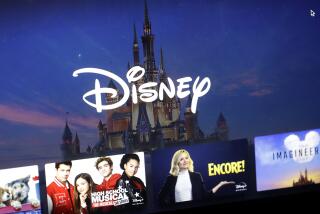Disney posts another strong quarter as its clout grows

Walt Disney Co. posted another quarter of double-digit profit growth, the latest sign of the Burbank entertainment giant’s snowballing financial clout.
The stellar second-quarter earnings — $2.1 billion — sailed past Wall Street projections and sent the company’s stock to an all-time high.
Hitting these marks has given Disney Chairman and Chief Executive Robert Iger a coveted currency: Analysts say the company is increasingly asserting its will in disputes and negotiations. In recent months, the entertainment giant has sued Verizon Communications Inc. over a new television service and clashed with theaters owners over discount tickets.
“There is no question that Disney has a lot more leverage today than they did even a year or two ago — whether it is digital, or movies or television,” said Tuna Amobi, an S&P Capital IQ analyst. “They have become much more of a ‘must have.’ They have more franchises than ever.”
On a conference call with analysts Tuesday, Iger fielded several questions about how the company has leveraged its strong position — including with last week’s release of “Avengers: Age of Ultron.” The Marvel Studios movie scored the second-biggest U.S. box-office opening ever and has grossed more than $650 million worldwide since its release Friday.
Disney imposed new rules on when theaters could show discount screenings of its films, including “Avengers.” The company has also sought to change the way ticket sales revenue is calculated in some instances.
The dispute centers on terms of a licensing agreement amended by Disney in March.
In a recent letter to Disney, John Fithian, president of the National Assn. of Theatre Owners, said he had received “an avalanche of complaints, concerns and fears” from his members over the licensing agreement.
Fithian’s letter also cited concerns about Disney’s stipulation that it would use a national average ticket price as the basis for calculating box-office revenue splits in certain circumstances, rather than the standard practice of using local market prices. Such a practice, Fithian wrote, would discourage theaters from offering discounts and lead to a “cycle of price increases” that may violate federal and state price-fixing rules.
“My concern is that it’s going to cost me more to play a film in Minneapolis than it is in Los Angeles, which may in turn force me to raise ticket prices in a market that may not be able to sustain the increase,” said Ted Mundorff, chief executive of Landmark Theatres, which operates 55 theaters nationwide.
Disney is exploring other ways to calculate revenue splits that would not use a national ticket price average. A spokesman for the company said it has heard from only a handful of exhibitors and is willing to discuss the matter with any interested theater owners.
Disney renegotiated its terms with exhibitors in 2013, allowing it to command a more generous cut of the box-office take on certain tent-pole pictures. The company will receive about 60% of receipts in the U.S. and Canada on the “Avengers” film.
That’s well above the roughly 50/50 revenue split typically agreed upon by studios and theater owners, although other studios have received 60% of the revenue on certain blockbuster films in recent years.
Iger was asked about the dispute with theater owners, first reported by the Wall Street Journal, during Tuesday’s conference call.
“We have obviously with our film strategy created and will continue to create huge value for the theater owners here in the United States and around the world,” he said. “And clearly with the hand that we have got — Disney and Pixar and Marvel and ‘Star Wars’ — our discussions in terms of the rates that we get paid or the splits have factored in the films that we release.”
The strategy, along with a continuing string of hits, has resulted in a remarkable run of profits. Net income jumped 10% in the second quarter over the same period last year — marking the sixth time in the last seven quarters that Disney has recorded double-digit profit growth.
Robin Diedrich, an analyst at Edward Jones Research, said that the success of the new “Avengers” film and other Disney movies gives the company “a little more leverage than other brands, frankly, in going to talk to theater owners.”
Disney has become a kingmaker of sorts in the world of streaming media because of the value of its properties and brands, which include ESPN, the Disney Channel, Pixar Animation Studios and Marvel.
Iger explained, for example, why Disney made a deal to put its content on Sling TV, the over-the-top streaming service that Dish Network recently launched.
He said that Disney found Sling TV appealing because it targets “broadband-only” homes — or those without cable or satellite television subscriptions. The inclusion of ESPN and other Disney-owned networks has been seen as a coup for Sling TV.
However, Disney did not make a deal with Sony’s relatively similar Vue service, which runs on the PlayStation gaming system. Iger was succinct in his appraisal of Vue: “Simply put, it wasn’t to our advantage financially.”
Diedrich said Disney has exacted price increases from distributors that want its content. “Now it’s even more important as distribution is expanding,” she said.
Iger also discussed a lawsuit filed by Disney against Verizon over a slimmed-down FiOS television package offering that includes ESPN as part of a sports bundle.
The lawsuit, filed last month in New York State Court, alleges that Verizon has violated contractual agreements that prohibit ESPN channels from being in a separate sports package.
“We were simply asking them to adhere to the contract that they had negotiated with us,” Iger said.
Iger also took time on the call with analysts to highlight successes from the quarter that ended March 28. The company delivered earnings of $1.23 a share, besting analyst predictions of $1.11.
The company’s domestic theme parks and its consumer products business were profit drivers during the quarter.
Disney’s parks and resorts unit posted operating income of $566 million, a gain of 24% from a year earlier. The company said the strong performance was partly because of increased guest spending at its domestic properties.
The company’s consumer products division reported operating income of $362 million, compared with $274 million a year earlier. Disney attributed the improvement partly to an increase in the licensing of merchandise from the hit animated movie “Frozen,” which was released in 2013 and grossed more than $1 billion.
Disney’s largest unit, its media networks division, posted operating income of $2.1 billion — down 2% from a year earlier. Revenue rose 13% to $5.81 billion.
On Tuesday, Disney’s stock hit an all-time high of $113.30 in intra-day trading. It closed down 22 cents, or 0.2%, to $110.81.
Times staff writer Richard Verrier contributed to this report.
More to Read
From the Oscars to the Emmys.
Get the Envelope newsletter for exclusive awards season coverage, behind-the-scenes stories from the Envelope podcast and columnist Glenn Whipp’s must-read analysis.
You may occasionally receive promotional content from the Los Angeles Times.









